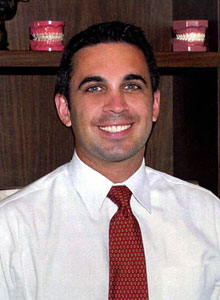Our team would like to point you to a few interesting webisodes about orthodontics, located on the YouTube page of the American Association of Orthodontists, or AAO.
There, they tend to post some very pertinent videos about orthodontic treatment, as well as state-of-the-art technology in orthodontia. These include "Orthodontic Treatment Basics," "Common Bite Problems Seen in Children" and "Does My Child Need Braces?"
We think you may find these webisodes interesting, as well as enlightening. If you have any questions about the videos, or your treatment here at our Basking Ridge, Mendham and Bedminster offices, please give us a call.
Friday, July 30, 2010
Friday, July 23, 2010
Drs. Nettune & Banasiak are supporting Moms for Mouth Guards
 Hey, Moms! Have you signed the Moms for Mouth Guards Pledge?
Hey, Moms! Have you signed the Moms for Mouth Guards Pledge?At our office, we care about your pearly whites, and we want to help keep you protected from sports injuries that can be damaging to your beautiful smile. As a way of ensuring that children are using proper facial protection equipment, our friends at the American Association of Orthodontics have introduced the Moms for Mouth Guards Pledge.
Mouth guards are vital to protecting your teeth from sports related injuries while participating in sports, such as football, soccer, baseball, hockey and basketball, just to name a few. The Moms for Mouth Guards Pledge is a way for moms nationwide to make a commitment to protecting their children’s smile from facial injuries.
We’ve discussed the importance of using facial protection in the past. Today, we thought we’d invite moms to take action by visiting the Moms for Mouth Guards
website and taking the Moms for Mouth Guards Pledge.
Have a safe week everyone!
Friday, July 16, 2010
What do you love about summer?

Summer is finally here, and the team at Drs. Nettune & Banasiak Orthodontic Associates thought we’d ask: What’s your favorite part about summer? Is it the warm weather? The free time you get? Spending quality time with friends and family? Grilling barbecue in the backyard?
We would like to know what makes your summer truly special. Let us know by posting on our Facebook page or by giving us a call!
Thursday, July 8, 2010
Invisalign Tips
 Many people know that Invisalign is a great solution to braces if you don't want to experience the look and feel of traditional metal braces. What few people know, though, is that just like traditional braces, Invisalign requires proper care to work effectively. Good oral hygiene is highly important, even when you are wearing something in your mouth that you can take out to eat with. It's still likely that your aligners can build up plaque if not treated properly. When wearing your Invisalign aligners, ask yourself the following questions:
Many people know that Invisalign is a great solution to braces if you don't want to experience the look and feel of traditional metal braces. What few people know, though, is that just like traditional braces, Invisalign requires proper care to work effectively. Good oral hygiene is highly important, even when you are wearing something in your mouth that you can take out to eat with. It's still likely that your aligners can build up plaque if not treated properly. When wearing your Invisalign aligners, ask yourself the following questions:1.) Am I eating with my aligners on? - These aligners are removable and should be taken out when you eat.
2.) Am I drinking anything other than water with my aligners on? - Though it's not a necessity for you to take out your aligners while you drink, think about how sticky a soda is. If you take out your aligners when drinking a soda, you have a better chance of keeping your aligners clean.
3.) Am I brushing before putting the trays on? - The aligners have both an inside and outside. Keeping the outside clean is easy. Keeping the inside clean is also easy: just make sure you've brushed your teeth before putting the trays on.
These are all very simple steps, and ultimately, they help to keep you building good oral habits.
-- Drs. Nettune & Banasiak
Friday, July 2, 2010
Your pal, fluoride
 There are so many ways you protect your teeth throughout your orthodontic treatment. You brush your teeth twice a day, floss regularly and protect your mouth and appliances from being damaged. But did you know there is another, often forgotten about, way to keep your teeth clean and healthy during your treatment? Fluoride – a mineral that helps prevent cavities and tooth decay – can help keep your teeth strong! Fluoride comes in two varieties: topical and systemic. Topical fluoride is applied directly to the tooth. Topical fluoride includes toothpastes and mouth rinses. Systemic fluorides are swallowed in the form of a dietary supplement.
There are so many ways you protect your teeth throughout your orthodontic treatment. You brush your teeth twice a day, floss regularly and protect your mouth and appliances from being damaged. But did you know there is another, often forgotten about, way to keep your teeth clean and healthy during your treatment? Fluoride – a mineral that helps prevent cavities and tooth decay – can help keep your teeth strong! Fluoride comes in two varieties: topical and systemic. Topical fluoride is applied directly to the tooth. Topical fluoride includes toothpastes and mouth rinses. Systemic fluorides are swallowed in the form of a dietary supplement.Fluoride used in the dentist/orthodontists’ office is often times a stronger concentration than in toothpaste or mouthwash, but is available at some drug stores or a pharmacy (ask your doctor how to purchase professional strength fluoride). A fluoride treatment typically takes just a few minutes. After the treatment patients may be asked not to rinse, eat or drink for at least 30 minutes in order to allow the teeth to absorb the fluoride. Depending on your oral health or doctor’s recommendation, you may be required to have a fluoride treatment every three, six or 12 months. Your doctor may also prescribe a fluoride product such as mouthwashes, gels or antibacterial rinses for at-home treatment.
When choosing your own fluoride product, be sure to check for the American Dental Association’s (ADA) seal of acceptance. Products marked with the ADA seal of approval have been carefully examined and have met the criteria of the ADA for safety and effectiveness. Take care of your teeth, and smile bright!
Subscribe to:
Posts (Atom)





